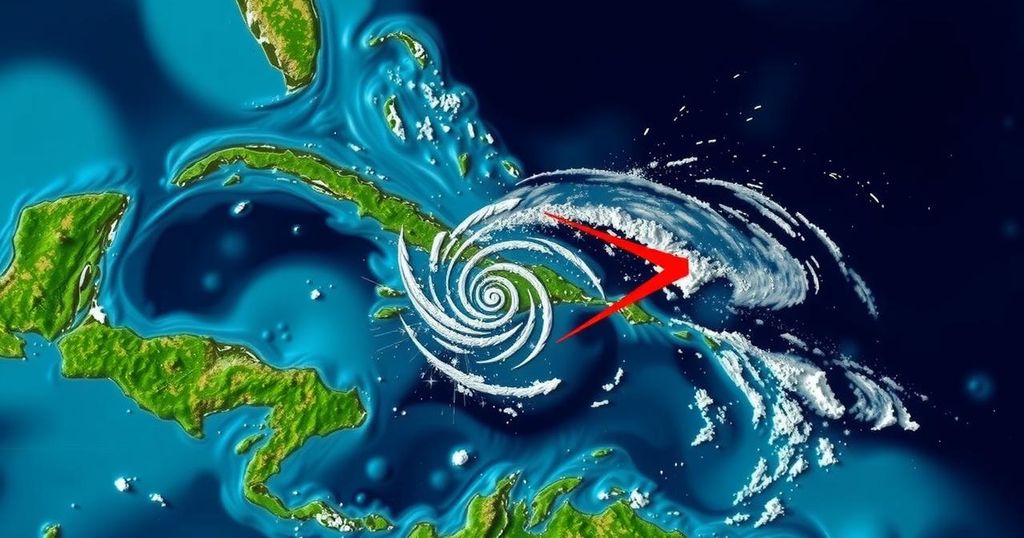Tropical Storm Oscar Advances Towards the Bahamas After Impacting Cuba

Tropical Storm Oscar is moving toward the Bahamas following its landfall in Cuba as a Category 1 hurricane, causing at least six fatalities and heavy rainfall. It has become notable as the smallest recorded hurricane. The storm has resulted in flooding and potential landslides in eastern Cuba, compounding the challenges faced by the island amid ongoing power issues. The Atlantic hurricane season is projected to be above average this year, with additional storms likely developing.
Tropical Storm Oscar is currently advancing toward the Bahamas following its landfall in Cuba as a Category 1 hurricane. The storm has resulted in at least six fatalities as it brought significant rainfall to an island that is concurrently grappling with a severe power outage. As of Tuesday morning, Oscar was positioned approximately 45 miles (75 kilometers) south-southeast of Long Island in the Bahamas, exhibiting wind speeds of 40 mph (65 kph) and traversing in a north-northeast direction at 12 mph (19 kph), as reported by the National Hurricane Center in Miami. As the storm continues to weaken, it remains notable for making history as the smallest hurricane on record, with a wind field barely spanning 6 miles (10 kilometers). Its unexpected development caught meteorologists off guard, as none of the forecasting models had indicated that Oscar would escalate into a hurricane. On Monday, Oscar released at least 15 inches (38 centimeters) of rainfall in specific regions of eastern Cuba, prompting alarms about severe flooding and potential landslides. The fatalities associated with the storm were confirmed in Guantánamo. The timing of Oscar’s impact is particularly critical as Cuba is recovering from a massive blackout that has incited small protests and warnings from the government against civil unrest. Oscar represents the 15th named storm and the 10th hurricane of the ongoing Atlantic hurricane season, which commenced on June 1 and will conclude on November 30. The National Oceanic and Atmospheric Administration has anticipated an above-average hurricane season this year, attributing it to record-high ocean temperatures, and forecasting 17 to 25 named storms along with four to seven major hurricanes reaching Category 3 or above. In a related development, Tropical Storm Kristy is currently situated over the open waters of the Pacific Ocean. On Tuesday, it was located 375 miles (605 kilometers) west-southwest of Acapulco, Mexico, with sustained winds of 50 mph (85 kph) and moving west-northwest at 15 mph (24 kph). Kristy is expected to strengthen into a hurricane by later that evening.
The Atlantic hurricane season, which runs from June 1 to November 30, inspires ongoing monitoring of storm systems that can significantly impact land and lives. Tropical Storm Oscar’s recent transition to a hurricane illustrates the variability and unpredictability inherent in storm forecasting. The unexpected landfall of Oscar in Cuba, coupled with severe rainfall leading to fatalities, underscores the dual challenges faced by the Cuban population—natural disasters amidst ongoing socio-economic difficulties following a major power outage. The National Oceanic and Atmospheric Administration’s predictions highlight concerns regarding climate change and its role in increasing the intensity and frequency of storms during hurricane seasons.
In conclusion, Tropical Storm Oscar has illustrated the complexities associated with hurricane preparedness and forecasting. Its impact on Cuba has been profound, with fatalities and significant rainfall contributing to fears of flooding and landslides. As Oscar heads toward the Bahamas, and with Kristy forming in the Pacific, the current hurricane season necessitates heightened vigilance and preparedness in affected regions, especially given NOAA’s forecast of an above-average storm season. This situation exemplifies the need for reliable forecasting and timely government responses in hurricane-prone areas.
Original Source: www.washingtontimes.com






